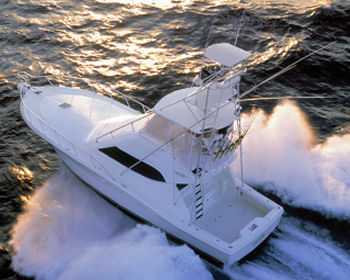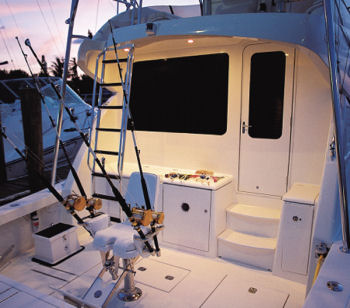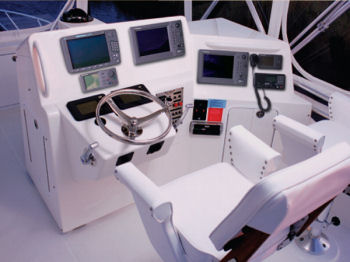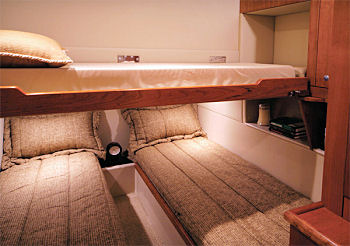Rampage 45 Convertible Beats Most of Her Peers
We count about a dozen 45' convertibles on the market these days. Most are surprisingly similar in fishing amenities and in salon and galley layout, but from there on they diverge. When we compared the Rampage 45 to the other 45' convertibles we discovered exactly how carefully she was designed to meet her competition, besting most in the critical areas of performance, fuel and economy. What is left, except price? On that score you'll find the Rampage 45 a world-beater. This article gives you the comparison data you need to make a decision.
The origins of the Rampage 45 design
are the famous boat building traditions of the Carolinas. The charter boat fishing
fleets on North Carolina's Outer Banks had to handle some of the toughest conditions
on the east coast to make a living. Once beyond the barrier islands they had a long
way to go to find the fishing grounds. It is notoriously rough around the Cape Hatteras
area, and these fishing boats had to pass that and go all the way out to the edge
of the Gulf Stream in many cases in the hunt.

|
|
A 16’ beam gives the Rampage 45 wide side decks, more room below and added stability. |
They had to get out there fast because it was a long way
and they had to get back in one day. These charter captains needed boats that were
fast but also they had to be economical because their livelihood depended on the
margin between fuel expenses and the charter day rate. As a result, a Carolina hull
design evolved that was sharp forward with bow flair and relative flat aft to give
the boat lift and make it easier to push, requiring smaller engines and burning
less fuel. That is an important part of the "back story" of the Rampage 45.
Beam Counts
When we looked at the 12 boats in this class we discovered that the Viking 45 had
the widest beam at 16'4". Beam is important as it gives a boat stability and more
room below and in the cockpit. It also gives the boat more wetted surface and it
could also make the boat heavier, both of which make the boat harder to push. With
a 16' beam the Rampage was the second widest boat of the dozen.

|
|
The business end of the Rampage is well-executed to satisfy the most demanding angler. |
Shoal Draft is Important
Being able to traverse skinny water is an important attribute for any boat. Not
only does shoal draft allow a boat to cross the Bahamas Banks, but also lots of
other places in the world. And at 45' the boat is not so big that it can't be used
for inshore fishing, in bays, shallow sounds and in rivers. When it comes to shallow
draft, at 4'0" the Rampage 45 ranks second again; this time second to the Riviera
45 which draws 3'11", one inch less.
Deadrise Costs Money
When it comes to deadrise at the transom, the Rampage 45 has the lowest at 12-degrees.
That is relatively flat and means the boat has a lot of lifting surface. It also
tends to reduce roll when trolling, drifting or at anchor. High deadrise boats are
harder to push and generally take more horsepower to reach desired speed. The highest
deadrise we encountered among the 12 boats was 18.5-degrees, a design that should
be more comfortable at high speed in rough seas. But when it’s rough, most people
prefer to throttle back and not go shooting off of wave tops pounding the hell out
of the boat and the passengers.

|
|
One of the best designed flying bridge helm consoles in its class. Note that the console to starboard is canted to make the third screen easy to read for the helmsman. |
Displacement vs. Speed
Displacement is critical because that will largely determine, along with hull shape,
how much horsepower it will take to move the boat. At 36,000 lbs. the Rampage 45
ranks the second lightest boat, with the Cabo 43 (which has a 46' LOA) coming in
at 33,000 lbs. The Viking 45 was 27% heavier at 49,750 lbs.
Every builder will tell you that their fishing customers want to go at least 40
mph at top end, and not surprisingly most of the boats on our list will do that
speed. But the question is with what engines and how much fuel will they burn to
move the needle to 40 mph? In the case of the Rampage 45 we tested, twin 800-hp
Cats did the job at 40.3 mph WOT. With these engines she burned 76 gph at WOT. At
best cruise (29 mph) she burns 45 gph and at 22 mph, or 19.6 knots where we like
to run, she burns only 37 gph. The heavier boats will require bigger, more expensive
engines to get the same speeds and will probably burn more fuel.

|
|
The port side guest cabin has a clever Pullman berth for a third angler. |
Range is Critical
Range is also often an issue with fishing boats, so displacement and fuel burn are
important for reasons other than cash. Not surprisingly the heaviest boat of the
dozen (the Viking 45) carries the most fuel (848 gallons). The Rampage was second
and tied with the Cabo 43, both with 700 gallons of fuel capacity. At best cruise
the Rampage 45 has over 400 statute miles of range.
Put this all together and we think the Rampage 45 clearly ranks as a world-class
convertible with a lot of practicality and designed-in economical operation. If
you are in the market for a 45' convertible, clearly the Rampage 45 should be on
your short list.
To find out more about the
details of the boat, read our Captain’s Report…
See video of Rampage
45 test…
See tests of all Rampage boats…